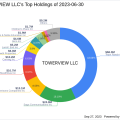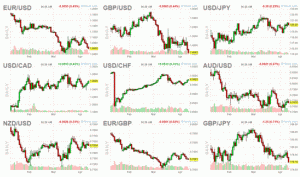- The US Dollar weaker with US GDP in line of expecations and Jobless Claims still tight.
- Equity markets are shaky after Wednesday’s 500-points drop in the Dow Jones.
- The DXY US Dollar Index is torn between risk-on mood and Fed speakers pushing back on rate cut bets.
The US Dollar (USD) trades lower on Thursday in the European session, after a very calm Asian one. From a technical point of view, the US Dollar Index (DXY) is likely to face a breakout soon, and lower liquidity ahead of Christmas could lead to large moves as the economic calendar gains momentum at the end of the week.
On the economic front, some heavyweight data has hit the markets on Thursday. All eyes were on the third estimate of the US Gross Domestic Product (GDP) reading. Although not much movement is expected in this third reading, it was enough to push the DXY lower. Strangely enough markets are ignoring the strong Jobless numbers yet again.
Daily digest Market Movers: Markets lost logic
- UBS is warning investors for a bull trap ahead in the current recovery rally in US equities, after the firm sell-off seen Wednesday.
- Russia tells Japan that military exercises with the US and Australia on Hokkaido are seen as a potential threat to its security.
- Angola has announced it will leave OPEC+. The news does not come as a surprise seeing the latest spat in the most recent OPEC+ gathering where Saudi Arabia asked of all participants to have production cuts. Angola and some other African nations issues vetoes against this demand.
- A very chunky batch of data was released at 13:30 GMT:
- The third estimate of US Gross Domestic Product (GDP) numbers. Economic growth was resived down to 4.9%, from the 5.2% annualized rate in the third quarter. The Personal Consumption Expenditures Prices for the quarter went from 2.8% to 2.6%..
- Weekly Initial Jobless Claims came out stronger again with Weekly Claims dropping from 213,500 to 212,000. Continuing Claims went from 1,866,000 to 1,865,000. Though seeing the initial market reaction, these numbers got ignored.
- At 16:00 GMT, the Kansas Fed Manufacturing Activity Index for December will be published. The previous number was at -3.
- Equities are struggling for direction after US equities sold off in the last trading hour on Wednesday. Japanese equities saw profit taking, with more than 1% losses in both the Nikkei and Topix indexes. European indices are down by 0.50%, while US equities futures are up 1% and are fully erasing Wednesday’s decline.
- The CME Group’s FedWatch Tool shows that markets are pricing in an 87.6% chance that the Federal Reserve will keep interest rates unchanged at its January 31 meeting. Around 12.4% expect the first cut already to take place.
- The benchmark 10-year US Treasury Note trades near 3.85%, the lowest level since summer.
US Dollar Index Technical Analysis: Markets ignore Jobless data
The US Dollar Index is in full consolidation mode. With clear lower highs and higher lows, buyers and sellers are pushed toward each other. A breakout looks primed for either Thursday (with the US GDP and Jobless Claims releases) or Friday (with Durable Goods and Personal Consumption Expenditures numbers). Either way, the US Dollar could still sink or rally by 1% into the last trading day before Christmas.
Any upbeat surprise in data that could contradict rate cuts bets or geopolitical events that trigger US Dollar inflow could still make the DXY head higher. On the daily chart, look for 103.00 as the first level to watch. Once trading above there, the 200-day Simple Moving Average (SMA) at 103.50 is the next important level to get to.
To the downside, the pivotal level at 101.70 – the low of August 4 and 10 – is vital to hold. Once broken, look for 100.82, which aligns with the bottoms from February and April. Should that level snap, nothing will stand in the way of DXY heading to the sub-100 region.
GDP FAQs
A country’s Gross Domestic Product (GDP) measures the rate of growth of its economy over a given period of time, usually a quarter. The most reliable figures are those that compare GDP to the previous quarter e.g Q2 of 2023 vs Q1 of 2023, or to the same period in the previous year, e.g Q2 of 2023 vs Q2 of 2022.
Annualized quarterly GDP figures extrapolate the growth rate of the quarter as if it were constant for the rest of the year. These can be misleading, however, if temporary shocks impact growth in one quarter but are unlikely to last all year – such as happened in the first quarter of 2020 at the outbreak of the covid pandemic, when growth plummeted.
A higher GDP result is generally positive for a nation’s currency as it reflects a growing economy, which is more likely to produce goods and services that can be exported, as well as attracting higher foreign investment. By the same token, when GDP falls it is usually negative for the currency.
When an economy grows people tend to spend more, which leads to inflation. The country’s central bank then has to put up interest rates to combat the inflation with the side effect of attracting more capital inflows from global investors, thus helping the local currency appreciate.
When an economy grows and GDP is rising, people tend to spend more which leads to inflation. The country’s central bank then has to put up interest rates to combat the inflation. Higher interest rates are negative for Gold because they increase the opportunity-cost of holding Gold versus placing the money in a cash deposit account. Therefore, a higher GDP growth rate is usually a bearish factor for Gold price.




